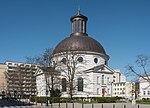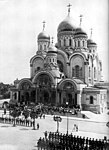Zachęta
1860 establishments in PolandArt museums and galleries in PolandArt museums established in 1860Museums in WarsawPages containing links to subscription-only content ... and 1 more
Tourist attractions in Warsaw

The Zachęta National Gallery of Art (Polish: Zachęta Narodowa Galeria Sztuki) is a contemporary art museum in the center of Warsaw, Poland. The Gallery's chief purpose is to present and support Polish contemporary art and artists. With numerous temporary exhibitions of well-known foreign artists, the gallery has also established itself internationally. The word "zachęta" means encouragement. The Zachęta Gallery takes its name from Towarzystwo Zachęty do Sztuk Pięknych (the Society for Encouragement of the Fine Arts), founded in Warsaw in 1860.
Excerpt from the Wikipedia article Zachęta (License: CC BY-SA 3.0, Authors, Images).Zachęta
Plac Stanisława Małachowskiego, Warsaw Śródmieście (Warsaw)
Geographical coordinates (GPS) Address Nearby Places Show on map
Geographical coordinates (GPS)
| Latitude | Longitude |
|---|---|
| N 52.239 ° | E 21.011 ° |
Address
XI Liceum Ogólnokształcące im. Mikołaja Reja
Plac Stanisława Małachowskiego 1
00-063 Warsaw, Śródmieście (Warsaw)
Masovian Voivodeship, Poland
Open on Google Maps











